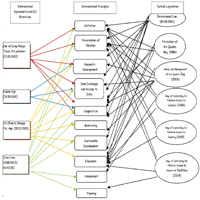
Forests and forestry organizations from the forest villagers’ perspective: a case study from Turkey
Hasan Alkan (1), Mehmet Kilic (2)
iForest - Biogeosciences and Forestry, Volume 7, Issue 4, Pages 240-247 (2014)
doi: https://doi.org/10.3832/ifor0999-007
Published: Mar 10, 2014 - Copyright © 2014 SISEF
Research Articles
Abstract
The forest villages of Turkey comprise approximately 11% of the population, where people live in poverty, and have low welfare levels due to insufficient income. The livelihood of many villagers is integrally tied to the forest, and the communities have varied expectations and demands from forest resources. In recent years, local expectations have placed substantial pressures on forests resources. Therefore, the opinions, expectations, and perceptions of forest villagers in regards to forest resources are vital in forest management. Furthermore, the views from the forestry organization that manages natural resources, and forestry strategies, policies, and practices are integral to ensure local villager satisfaction, and participation in natural resource conservation objectives. The aims of this study were to evaluate villagers’ opinions regarding the surrounding forests and forestry organizations, quantify the residents’ satisfaction level with life in the forest village, and determine the influential factors responsible for the residents’ responses. Forest villagers (1059 people) living in the Sivas Directorate of Forest District participated in the study, and a questionnaire was administered in 11 villages within a field work framework to serve as a case study. Results indicated the region has very limited alternative livelihood sources, and forestry is the leading regional source of income for villagers. Therefore, residents from all 11 villages are dependent on forest resources. The questionnaire showed employment facilities were the most important forest benefits. Overall, the villagers were satisfied with available forestry jobs and other associated opportunities, however wages were considered insufficient, and workers expressed expectations for significant changes in labor safety conditions. In addition, certain prohibitions and restrictions placed on regional natural resources prevent residents from previous land-use practices, which adversely affected local opinions towards forests and forestry organizations. For example, strict forest protection measures will make obsolete the nomadic livestock breeding practices of some local villagers. This is the most common complaint directed at forestry activities, and will have an impact on the local income levels.
Keywords
Forest Villagers, Forest Resources, Perspective, Satisfaction, Sivas Directorate of Forest District, Turkey
Authors’ Info
Authors’ address
Faculty of Forestry, Süleyman Demirel University, East Campus, 32260, Isparta (Turkey)
Sivas Forest Directorate, Akdegirmen District, Niksar Street, Sivas (Turkey)
Corresponding author
Paper Info
Citation
Alkan H, Kilic M (2014). Forests and forestry organizations from the forest villagers’ perspective: a case study from Turkey. iForest 7: 240-247. - doi: 10.3832/ifor0999-007
Academic Editor
Paola Mairota
Paper history
Received: Mar 29, 2013
Accepted: Feb 21, 2014
First online: Mar 10, 2014
Publication Date: Aug 01, 2014
Publication Time: 0.57 months
Copyright Information
© SISEF - The Italian Society of Silviculture and Forest Ecology 2014
Open Access
This article is distributed under the terms of the Creative Commons Attribution-Non Commercial 4.0 International (https://creativecommons.org/licenses/by-nc/4.0/), which permits unrestricted use, distribution, and reproduction in any medium, provided you give appropriate credit to the original author(s) and the source, provide a link to the Creative Commons license, and indicate if changes were made.
Web Metrics
Breakdown by View Type
Article Usage
Total Article Views: 52441
(from publication date up to now)
Breakdown by View Type
HTML Page Views: 44628
Abstract Page Views: 2756
PDF Downloads: 3831
Citation/Reference Downloads: 15
XML Downloads: 1211
Web Metrics
Days since publication: 4290
Overall contacts: 52441
Avg. contacts per week: 85.57
Citation Metrics
Article Citations
Article citations are based on data periodically collected from the Clarivate Web of Science web site
(last update: Mar 2025)
Total number of cites (since 2014): 6
Average cites per year: 0.50
Publication Metrics
by Dimensions ©
Articles citing this article
List of the papers citing this article based on CrossRef Cited-by.
References
SPSS 15.0 Veri Analiz Yöntemleri [SPSS 15.0 Data Analysis Methods] . Istatistik Merkezi Yayinlari, Turkey. [in Turkish]
Gscholar
Türkiye’de aglaçlandirma faaliyetinde çalisanlarin sorunlari (Manisa Ili Örnegi) [The problems of working in afforestation activities in Turkey (Manisa Province Sample)]. Ormancilikta Sosyo-Ekonomik Sorunlar Kongresi, Ilgaz, Turkey, pp. 80-86. [in Turkish]
Gscholar
Forest and village relations. Working Group Preliminary Report, Forestry Council, Ankara, Turkey, pp.140-172.
Gscholar
Çevre-orman-tarim ve halk iliskilerinin dinamikleri. 1. Çevre ve Ormancilik Åžurasi [Dynamics of forest, agriculture and public relations]. Antalya, Turkey, pp. 1567-1574. [in Turkish]
Gscholar
Bilimsel Arastirma Yöntemi: Kavramlar, Ilkeler, Teknikler [Scientific research methods: concepts, principles and techniques]. Turkey. [in Turkish]
Gscholar
The role of women in rural tourism, the sample of Gaziler Village (Bardiz), Erzurum, Turkey. Journal of Food, Agriculture and Environment 2: 1314-1319.
Gscholar
Paket Programlar ile Istatistiksel Veri Analizi [Statistical Data Analysis with Software]. Kaan Kitabevi, Turkey. [in Turkish]
Gscholar
Attitudes and perceptions of rural people towards forest protection within the scope of participatory, forest management: a case study from Artvin, Turkey. African Journal of Agricultural Research 12: 1399-1411.
Gscholar
Local people, nature conservation and tourism in Northeastern Finland. The Resilience Alliance Publication, Ecology and Society 1: 8-24.
Gscholar
Orman kaynaklari planlamasi ve yönetiminde katilimci yaklasimlar [Participatory approaches at planning & management of forest resources]. Ormancilikta Sosyo-Ekonomik Sorunlar Kongresi, Çankiri, Turkey, pp. 196-200. [in Turkish]
Gscholar

















